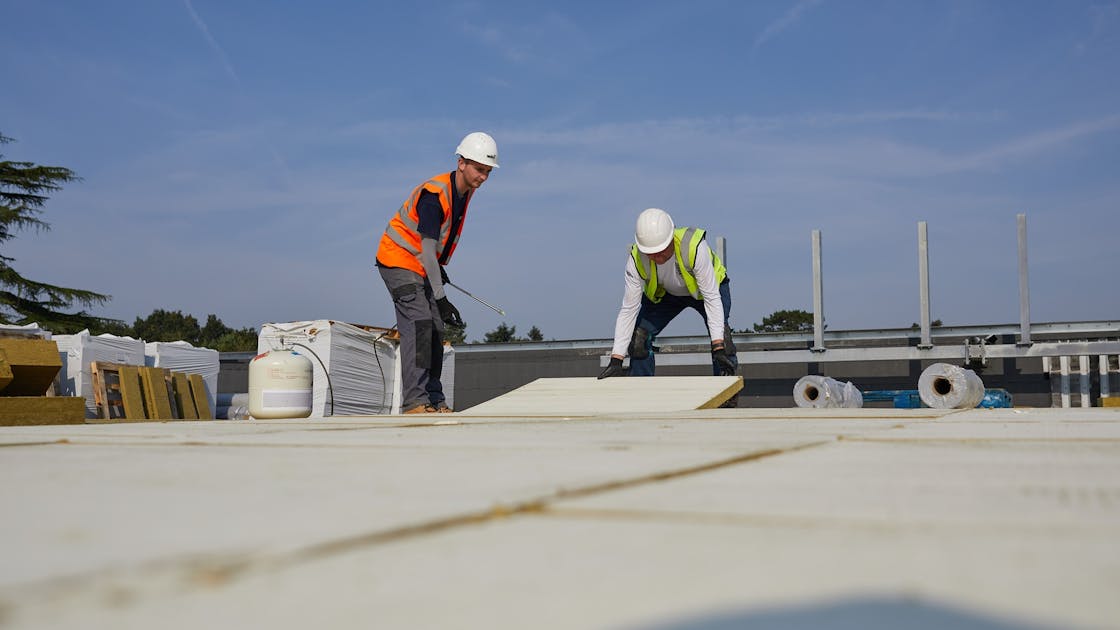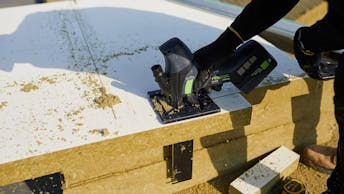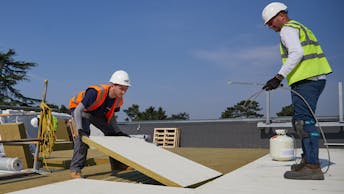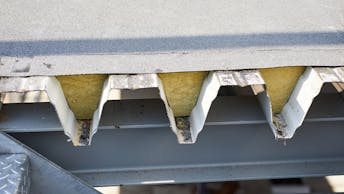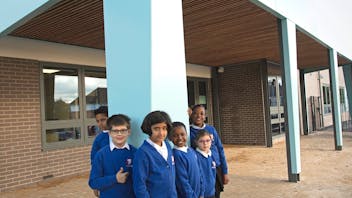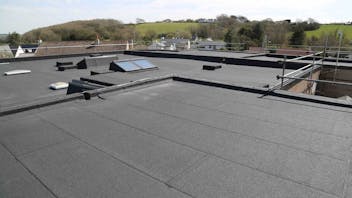The project
Constructed on a former office building site covering approximately 2.58 hectares, the new Cobham Free School, Surrey is being delivered as a phased programme that will realise a community vision for an all-through school from a single base.
Following the refurbishment of an existing 1990s office building into state-of-the-art teaching facilities, the school opened its doors to senior pupils in September 2020. Construction has now started on the addition of two adjoined new-build blocks which will expand the school's facilities to include a 520-seater auditorium, dining hall, recital room, sports hall, fitness/dance studio, and changing facilities.
With the two new school wings incorporating a flat roof construction, main contractor Willmott Dixon Construction appointed Southern Industrial Roofing to manage this specialist package. To meet the required performance for education buildings, Southern Industrial Roofing worked with ROCKWOOL® to design a robust acoustic and non-combustible insulation specification.
When the school fully opens in February 2021, junior pupils will relocate from temporary facilities to the new site, expanding the school to include greater numbers of pupils in all year groups, offering an all-round, traditional education to 1,064 children from 4 to 18 years old when it reaches capacity.
In addition to regulation compliance, rooftop plant and compartmentation in the internal walls below created a complex design challenge.
The challenge
With a warm flat roof specified for Cobham Free School, Southern Industrial Roofing had to balance multiple design considerations, starting with BS 6229: 'Flat roofs with continuously supported flexible waterproof coverings' and compliance with specific education sector building regulations.
While BB93 specified acceptable levels of rain noise transfer into various spaces, BB100 outlined fire protection considerations.
Simultaneously addressing these requirements was compounded by mechanical and electrical plant being housed on the flat roof, which demanded non-combustible zones to provide safe access for maintenance. Internal fire rated walls in the building below also required the flat roof to contribute to effective compartmentation.
As the architect upgraded the insulation specification to be noncombustible, the design had to be updated while minimising impact on the building footprint.
The solution
Simultaneously addressing these requirements was compounded by mechanical and electrical plant being housed on the flat roof, which demanded non-combustible zones to provide safe access for maintenance. Internal fire rated walls in the building below also required the flat roof to contribute to effective compartmentation.
The ROCKWOOL specification team hosted a CPD session which specifically addressed flat roof construction in the education sector, helping the teams to better understand the interfacing of systems and the role of insulation in ensuring compliance with the relevant regulations.
The flat roofs of the north and south wings span 800m² and 630m² respectively. These are constructed of both solid and perforated zones, defined by use of the spaces below. With an IKO Armourplan Single Ply Roofing System / Membrane specified, ROCKWOOL supported Southern Industrial Roofing in designing an insulated flat roof build-up which could simultaneously meet all the project’s needs.
Across the two new buildings, over 2000m² of ROCKWOOL HardRock® Multi-Fix (DD) has been installed to provide all-in-one acoustic, thermal, and fire performance. To minimise the fixings penetrating the roof deck, a bonded waterproofing system was used. ROCKWOOL provided an ideal insulation solution with this build-up as it removed the need for an additional barrier mat to reduce rain noise transfer.
Seeking to maintain the waterproofing as a single envelope, Southern Industrial Roofing also clad the internal parapet with the IKO single ply system and ROCKWOOL non-combustible insulation.
To help reduce reverberation in the dining room and auditorium, a perforated metal deck was specified. The converse impact of rain noise in these areas was mitigated by the installation of black tissue faced ROCKWOOL Acoustic Infills, friction fitted into the deck troughs.
Where the roof deck interfaced with the heads of internal compartmentation walls, ROCKWOOL Trapezoidal Fire Stops were installed.
The result
By using ROCKWOOL to insulate the warm flat roof, Southern Industrial Roofing has simplified overall design, achieved on-site efficiency gains and increased confidence in the performance of the system build-up.
Andy Towns, Designer at Southern Industrial Roofing, explains: "Flat roof construction has become more complex in recent years, having to navigate what are sometimes conflicting design criteria. For education buildings, this is further compounded as BB93 details varying acoustic performance levels for different spaces. By providing access to test evidence with a metal deck in the early design phases, we knew we could move forward with confidence, using ROCKWOOL as a robust acoustic solution for flat roofs – without the need for an additional barrier mat."
As non-combustible insulation, ROCKWOOL removed any concerns about roof zoning for maintenance access to the rooftop plant.
ROCKWOOL's technical expertise was invaluable during the early planning phases, when it soon became apparent that using stone wool for all the insulation requirements would be the most effective solution.
Once on-site, Southern Industrial Roofing realised further benefits they were not expecting: "As compared with other insulation, we found ROCKWOOL to be a much simpler build-up which saved us time. Plus, the friction fitting of the Acoustic Infills removed the need for any mechanical fixings, which gave a much cleaner and more aesthetic finish – especially with the black tissue facing.
Cobham Free School
89-95 Portsmouth Rd, Cobham KT11 1JJ




